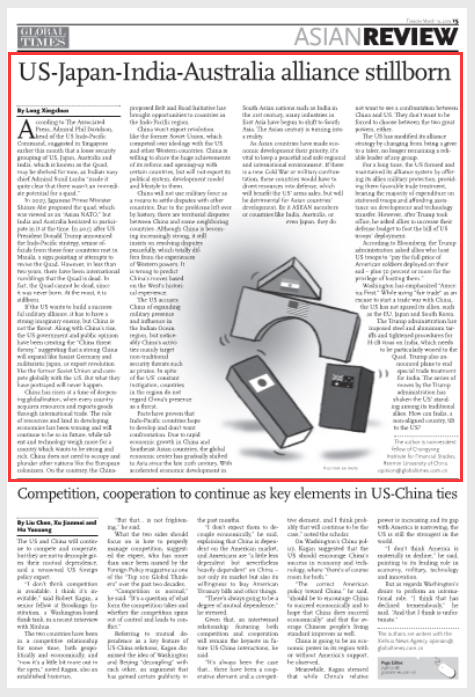Major Power Relations
Your Present Location: PROGRAMS> Major Power RelationsLong Xingchun: US-Japan-India-Australia alliance stillborn
By Long Xingchun Source: Global Times Published: 2019-3-18
According to The Associated Press, Admiral Phil Davidson, head of the US Indo-Pacific Command, suggested in Singapore earlier this month that a loose security grouping of US, Japan, Australia and India, which is known as the Quad, may be shelved for now, as Indian navy chief Admiral Sunil Lanba "made it quite clear that there wasn't an immediate potential for a quad."

In 2007, Japanese Prime Minister Shinzo Abe proposed the quad, which was viewed as an "Asian NATO," but India and Australia hesitated to participate in it at the time. In 2017, after US President Donald Trump announced the Indo-Pacific strategy, senior officials from these four countries met in Manila, a sign pointing at attempts to revive the Quad. However, in less than two years, there have been international rumblings that the Quad is dead. In fact, the Quad cannot be dead, since it was never born. At the most, it is stillborn.
If the US wants to build a successful military alliance, it has to have a strong imaginary enemy, but China is not the threat. Along with China's rise, the US government and public opinion have been creating the "China threat theory," suggesting that a strong China will expand like fascist Germany and militaristic Japan, or export revolution like the former Soviet Union and compete globally with the US. But what they have portrayed will never happen.
China has risen at a time of deepening globalization, when every country acquires resources and exports goods through international trade. The role of resources and land in developing economies has been waning and will continue to be so in future, while talent and technology weigh more for a country which wants to be strong and rich. China does not need to occupy and plunder other nations like the European colonizers. On the contrary, the China-proposed Belt and Road Initiative has brought opportunities to countries in the Indo-Pacific region.
China won't export revolution like the former Soviet Union, which competed over ideology with the US and other Western countries. China is willing to share the huge achievements of its reform and opening-up with certain countries, but will not export its political system, development model and lifestyle to them.
China will not use military force as a means to settle disputes with other countries. Due to the problems left over by history, there are territorial disputes between China and some neighboring countries. Although China is becoming increasingly strong, it still insists on resolving disputes peacefully, which totally differs from the experiences of Western powers. It is wrong to predict China's moves based on the West's historical experience.
The US accuses China of expanding military presence and influence in the Indian Ocean region, but noticeably China's activities mainly target non-traditional security threats such as pirates. In spite of the US' constant instigation, countries in the region do not regard China's presence as a threat.
Facts have proven that Indo-Pacific countries hope to develop and don't want confrontation. Due to rapid economic growth in China and Southeast Asian countries, the global economic center has gradually shifted to Asia since the late 20th century. With accelerated economic development in South Asian nations such as India in the 21st century, many industries in East Asia have begun to shift to South Asia. The Asian century is turning into a reality.
As Asian countries have made economic development their priority, it's vital to keep a peaceful and safe regional and international environment. If there is a new Cold War or military confrontation, these countries would have to divert resources into defense, which will benefit the US' arms sales, but will be detrimental for Asian countries' development. Be it ASEAN members or countries like India, Australia, or even Japan, they do not want to see a confrontation between China and US. They don't want to be forced to choose between the two great powers, either.
The US has modified its alliance strategy by changing from being a giver to a taker, no longer remaining a reliable leader of any group.
For a long time, the US formed and maintained its alliance system by offering its allies military protection, providing them favorable trade treatment, bearing the majority of expenditure on stationed troops and affording assistance on development and technology transfer. However, after Trump took office, he asked allies to increase their defense budget to foot the bill of US troops' deployment.
According to Bloomberg, the Trump administration asked allies who host US troops to "pay the full price of American soldiers deployed on their soil - plus 50 percent or more for the privilege of hosting them."
Washington has emphasized "America First." While using "fair trade" as an excuse to start a trade war with China, the US has not spared its allies, such as the EU, Japan and South Korea.
The Trump administration has imposed steel and aluminum tariffs and tightened procedures for H-1B visas on India, which needs to be particularly wooed to the Quad. Trump also announced plans to end special trade treatment for India. The series of moves by the Trump administration has shaken the US' standing among its traditional allies. How can India, a non-aligned country, tilt to the US?
The author is visiting fellow of Chongyang Institute for Financial Studies, Renmin University of China.























































































 京公网安备 11010802037854号
京公网安备 11010802037854号





